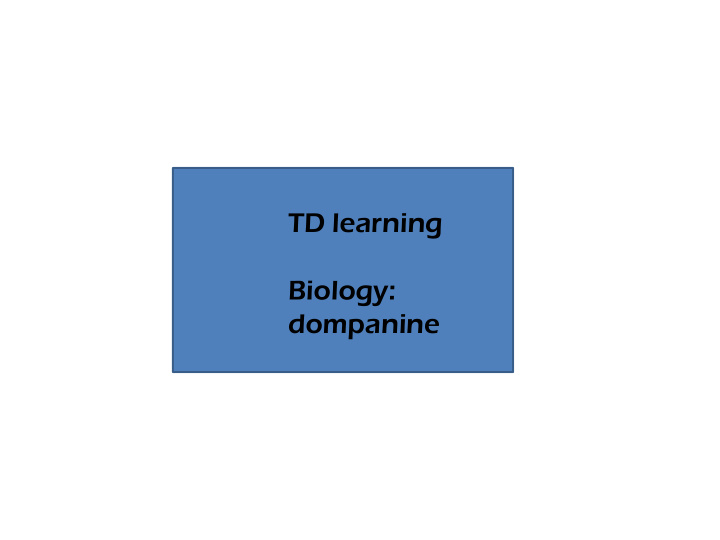



TD learning Biology: dompanine
TD(λ) Using a longer trajectory rather than single step: For a single step: The expected total Return from S on is: R(S) = r + γV(S’) For two steps:
TD(λ) n-step return at time t: Using a trajectory of length n Estimation of the total return based on n steps The value V(S) can be updated following n steps from S by:
Summary: generalizes the 1-step update n-step return at time t: The value V(S) can be updated following n steps from S by: Generalizes the 1-step learning : ΔV t (S t ) = α[r t+1 + γV t (S t+1 ) - V t (S t )]
Averaging trajectories: • It is also possible to average trajectories; we can use the sub-trajectories of the full length-n trajectory to update V(S). • A particular averaging (particular weights) is the TD(λ) weights : • The weights are 1 , λ, λ 2 ,… with all this multiplied by (1- λ) since a weighted average needs the sum of weights to be 1. •
λ – Return Using the single long trajectory we had: The λ – return is the weighted average of all lengths:
TD( λ ) And the learning rules: Singe long trajectory: TD(λ) learning:
Eligibility traces TD(λ) learning: To compute this at time t, we need the n next steps which we still do not have. We want at time t to update back, the previous n visited states. This can be done with ‘ eligibility trace Each visited state becomes ‘eligible’ for update, updates take place later:
Implementing TD(λ) with Eligibility Traces A memory called 'eligibility trace' is added to each state e t (S) It is updated by: The trace of S is incremented by 1 when S is visited, and decays by γλ at each step. Here γ is the discount factor and λ is the decay parameter.
Learning with eligibility traces Take a step, compute a singel-step TD error: Update V(S): V(S) is updated at each step, although the current step is different. If S was visited, then S1, S2, S3, then V(S) will be updated with the error of each of them. δ
The full TD(λ) Algorithm: V(S) is updated at each step, although the current step is different from S. If S was visited, then S1, S2, S3, then V(S) will be updated with the error of each of them.
Eligibility traces Updating state values V(S) by eligibility traces is mathematically identical to the ‘forward’ TD(λ ) learning: The update does not rely on future values, and has plausible biological models.
SARSA (λ)
Eligibility traces – biology
SDTP
Eligibility
Synaptic Reinforcement
Dopamine story
Behavioral support for ‘prediction error’ Associating light cue with food
‘Blocking’ No response to the bell The bell and food were consistently associated There was no prediction error, prediction error, not association, drives learning
Rescola - Wagner Associative learning occurs not because two events co-occur but because that co-occurrence is unanticipated on the basis of current associative strength. Α, β are rate parameters. V tot is the total association from all cues on this trial. λ is the currently expected value. Learning occurs if the current value V tot is different from expectation. Still no action selection, policy for behavior, long sequences
Iterative solution for V(S) V π (S) = < r 1 + γ V π (S') > V(S) ← V(S) + α [ (r + γV(S’)) – V(S) ] Error Prediction error, TD error
• Learning is driven by the prediction error: • δ(t) = r + γV(S’)) – V(S) • Computed by the dopamine system • (Here too, if there is no error, no learning will take place)
Domaminergic neurons • Dopamine is a neuro-modulator • In the: • VTA (ventral tegmental area) • Substantia Nigra • These neurons send their axons to brain structures involved in motivation and goal- directed behavior, for example, the striatum, nucleus accumbens, and frontal cortex.
Major players in RL
Effects of dopamine, why it is associated with reward and reward related learning • drugs like amphetamine and cocaine exert their addictive actions in part by prolonging the influence of dopamine on target neurons • Second, neural pathways associated with dopamine neurons are among the best targets for electrical self-stimulation. • animals treated with dopamine receptor blockers learn less rapidly to press a bar for a reward pellet
Self stimulation
• You can put a stimulating electrode in various places. In the Dopamine system (e.g. VTA), the animal will continue stimulating. • In the Orbital cortex for example you can put the electrode in a taste-related sub-region, activated by food. The animal will stimulate the electrode when it is hungry, but will stop activating when he is not.
Dopamine and prediction error The animal (rat, monkey) gets a cue (visual, or auditory). A reward after a delay (1 sec below)
Dopamine and prediction error
TD, prediction error Conclusion of the biological study
Computational TD learning is similar: Take a step, compute a TD error: Update V(S): V(S) is updated at each step, although the current step is different. If S was visited, then S1, S2, S3, then V(S) will be updated with the error of each of them. δ
Recommend
More recommend